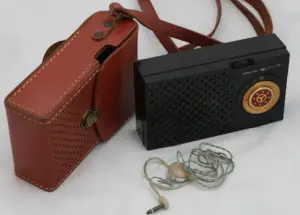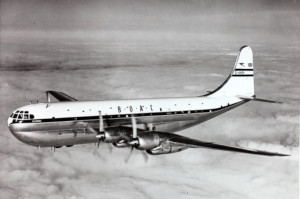General Electric 675 radio

One of the joys of owning products from the past is that they tell a story. From this American pocket transistor radio from 1956 I was able to piece together a considerable amount of information. I found out who owned it and how it came to be in the United Kingdom.
This radio is a General Electric 675. It is an early pocket transistor radio.
A middle-aged Englishman, Mr M A Rowe, bought this radio on a trip to the USA in the summer of 1956. For him was a new discovery. Pocket radios were unheard of in the UK in 1956. The first one went on sale in America only eighteen months previously.
He probably bought the radio in a New York store, possibly Liberty Music Shops. They advertised this radio in December 1955 in the New York Times.
The General Electric 675 was not the world's first pocket transistor radio. It was General Electric's (GE's) first transistor radio and the second design to be pocket-sized.
GE launched the 675 in 1955. At first, it was only available in ebony or antique white. Other colours were added later and had different model numbers as shown below:
- Ebony - 675
- Ivory - 676
- Red - 677
- Turquoise - 678
The GE 675 was similar, but a little larger than the Regency TR1, the first transistor radio which went on sale in the fall of 1954.

The GE 675 could pick up only AM on the medium wave band. It had a real cowhide case and an earphone, which you had pay extra for. The case had a hint of a folding camera case. The whole package had the feel of an expensive instrument.
It was an expensive radio. The price was $49.95. At the time, GE sold a tube (valve) portable for $19.95. In today's money (2023) $49.95 would be around $550. An equivalent product from today would be a mid-range smart phone.
Liberty Music Shops retailed this radio in New York. They charged an extra $3.95 for the case and $5.95 for the earphone. Liberty Music Store had branches in Madison Avenue (450, 975 and 795) and at 228 East Post Road.
By the end of 1956 there were several small radios by US makers on sale.
- Zenith Royal 500-Y - $75
- RCA Victor 7-BT-9J - $65
- Raytheon T-150-1 - $69.95
- Crosely JM-8-GN - $50
- Raytheon T-100 - $49.95
- Mitchell 1101 - $49.95
- Regency TR1 - $49.95
Source: Consumer reports 1957 buying guide (published 1956), pages 158-9

The typical 1956 customer was not the pop-music obsessed teenager. They would more likely be a smart lady who wanted to carry a radio as an accessory in her handbag, or a businessman who wanted to pack the radio in his suitcase for travelling. At least that's what GE's advertising suggested. The owners might also have been the children of the well-heeled.
The design reflected the minimalist international style which was good taste at the time. Later pocket transistor radios reflected automotive or space-age styling to appeal to younger customers.
American consumers soon discovered that whilst transistor radios could be made much smaller than their tube counterparts, there was a price to be paid in the quality of sound. A larger radio in a large cabinet with a large speaker sounded better than a pocket-sized radio.
Nevertheless, pocket-sized radios were what people wanted.

Image pubic domain (SDASM Archives
Mr Rowe, who bought this radio, flew back to the UK on BOAC's Boeing Stratocruiser 377 G-ALSC "Centaurus" in June 1956. I know this because he had to pay an extra £6 6s ($17.64) import duty on the radio and he kept the receipt.
The Stratocruiser was a propeller-driven airplane. Stratocruisers were the luxury way to cross the pond before the jet era. James Bond flew by BOAC Stratocruiser to New York in the novel (not the film) Diamonds are Forever, published also in 1956.
The top level of luxury onboard the Stratocruiser included fully reclining seats or bunk beds, a cocktail bar on the lower deck, gourmet cuisine and the finest wine and champagne.
Although by 1956 BOAC was also offering the more basic tourist class service on some Stratocruiser flights.
Mr Rowe's radio would have been a novelty when he brought it back to the UK.
It would be another three years before UK radios approaching this size went on sale. The shine might have worn off more quickly as he would have found its specialist battery hard to get the UK.
(*) Prices adjusted for inflation.
By Steven Braggs, April 2023


Comments